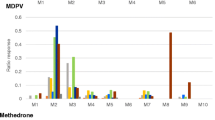Abstract
Domestic guinea pigs having high levels of circulating testosterone (i.e., males and castrate males receiving testosterone propionate injections) excrete in their urine equal amounts of both thesyn andanti isomers of phenylacetaldehyde oxime, while those guinea pigs having low testosterone titers (i.e., females, castrate males, and juveniles) excrete neither. These aldoximes were also detected in the urine of wild male guinea pigs. Radiolabeling studies in the domestic guinea pigs strongly suggest that these aldoximes are derived from phenylalanine. To our knowledge this is the first observation and isolation of phenylacetaldehyde oxime from a mammalian source. The significance of these components in phenylalanine metabolism as well as in guinea pig chemical communication is discussed.
Similar content being viewed by others
References
Beauchamp, G.K. 1973. Attraction of male guinea pigs to conspecific urine.Physiol. Behav. 10:589–594.
Beauchamp, G.K., andBerÜter, J. 1973. Source and stability of attractive components in guinea pigs (Cavia porcellus) urine.Behav. Biol. 9:43–47.
Beauchamp, G.K.,Magnus, J.G.,Shmunes, N.T., andDurham, T. 1977. Effects of olfactory bulbectomy on social behavior of male guinea pigs(Cavia porcellus).J. Comp. Physiol. Psychol. In press.
BerÜter, J., Beauchamp, G.K., andMuetterties, E.L. 1973. Complexity of chemical communication in mammals: Urinary components mediating sex discrimination by male guinea pigs.Biochem. Biophys. Res. Commun. 63:264–271.
Birch, M.C. (ed.), 1974. Pheromones. Elsevier, New York.
Brownlee, R.G., andSilverstein, R.M. 1968. A micro-preparative gas Chromatograph and a modified carbon skeleton determinator.Anal. Chem. 40:2077–2079.
Conn, E.E. 1973. Biosynthesis of cyanogenic glycosides.Biochem. Soc. Symp. 38:277–302.
Doffus, W. 1892. Uber die Configuration von Aldoximen.Ber. 25:1908–1936.
Doty, R.L. (ed.). 1976. Mammalian Olfaction, Reproductive Processes and Behavior. Academic Press, New York.
Gehrke, C.W., andLeimer, K. 1971. Trimethylsilylation of amino acids: Derivitization and chromatography.J. Chromatog. 57:219.
Goldsmith, D., Becker, D., Sample, S., andDjerassi, C. 1966. Mass spectrometry in structural and stereochemical problems: A study of the fragmentation processes of Oximes.Tetrahedron Suppl. 7:145–173.
Kindl, H., andUnderhill, E.W. 1968. Biosynthesis of mustard oil glucosides:n-Hydroxyphenylalanine, a precussor of glucotropaeolin and a substrate for enzymatic and nonenzymatic formation of phenylacelaldehyde oxime.Phytochemistry. 7:745–756.
Mika, M., 1973. Mass spectral analysis of oxime derivatives. Ph.D. Thesis. University of Illinois. University Microfilms International, 74–27, 294.
Preti, G.,Smith, A.B., III andBeauchamp, G. 1977. Chemical and behavioral complexity in mammalian chemical communication systems: Guinea pigs (Cavia porcellus), marmosets(Saguinus fuscicollis) and humans(Homo sapiens), in Müller-Schwarze and Mozell, (eds.). Chemical Signals in Vertebrates. In press.
Smith, A.B., III,Byrne, K.J., andBeauchamp, G.K. 1975. Unpublished results.
Stalling, D.L., Gerhke, C.W., andZumwalt, R.W. 1968. A new silylation reagent for amino acids. Bis(trimethylsilyl)trifluoroacetamide (BSAFA).Biochem. Biophys. Res. Commun. 31:616.
Tapper, B.A., andButler, G.W. 1967. Biosynthesis of mustard oil glucosides: Conversion of phenylacetaldehyde oxide and 3-phenylpropionaldehyde oxime to glucotropaeolin and gluconasturtiin.Arch. Biochem. Biophys. 120:719–721.
Underhill, E.W. 1967. Conversion of oximes to mustard oil glucosides (glucosinolates).Eur. J. Biochem. 2:61–63.
Underhill, E.W., Wetter, L.R., andChisholm, M.D. 1973. Biosynthesis of glucosinolates.Biochem. Soc. Symp. 38:303–326.
Author information
Authors and Affiliations
Rights and permissions
About this article
Cite this article
Smith, A.B., Byrne, K.J. & Beauchamp, G.K. Syn- andanti-phenylacetaldehyde oxime two novel testosterone-dependent mammalian metabolites. J Chem Ecol 3, 309–319 (1977). https://doi.org/10.1007/BF00988446
Received:
Accepted:
Issue Date:
DOI: https://doi.org/10.1007/BF00988446




